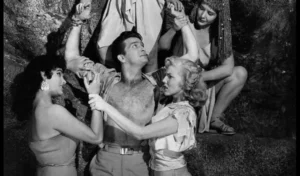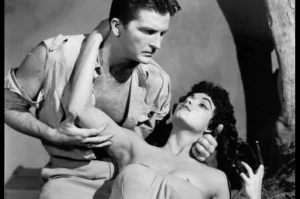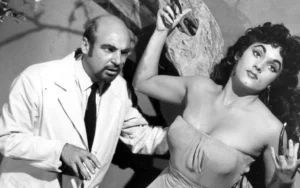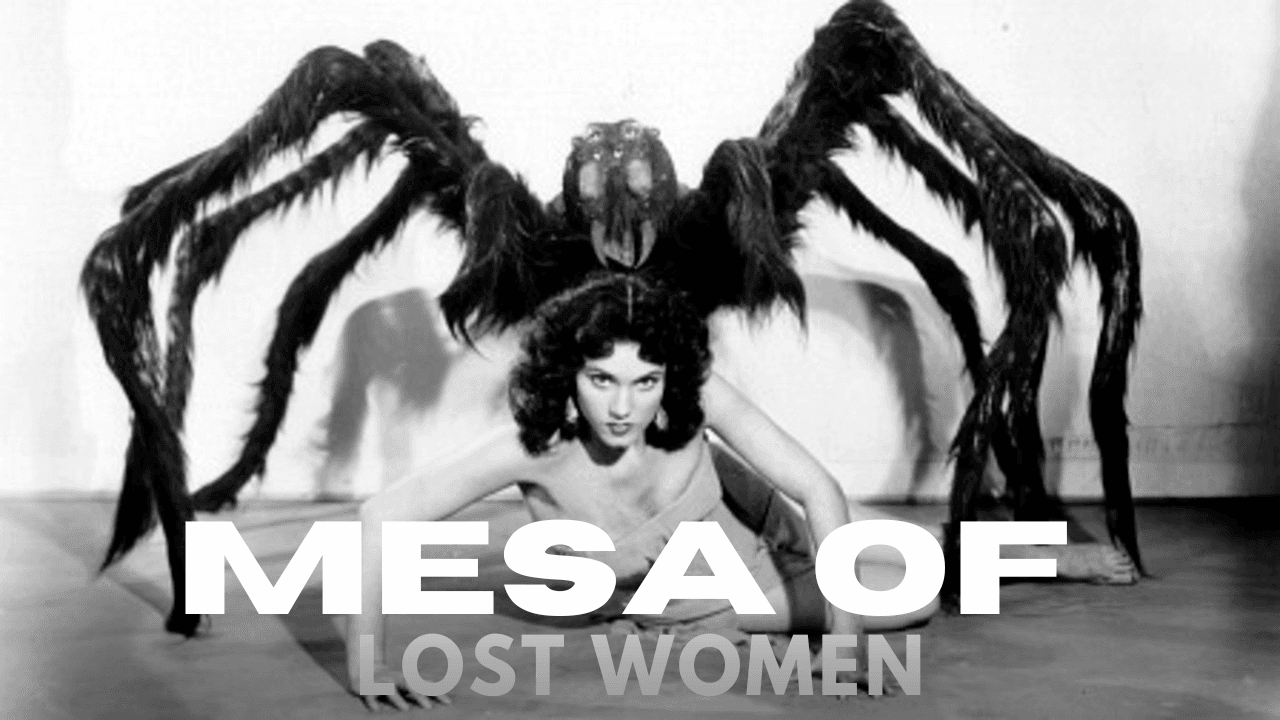A B-Movie Masterpiece of Absurdity – Mesa of Lost Women (1953)
Introduction

In the annals of cult cinema, few films are as confounding and strangely mesmerizing as Mesa of Lost Women (1953).
A true relic of 1950s B-movie madness, this film is a blend of sci-fi, horror, and adventure that revels in its low-budget eccentricities.
So, with its bizarre plot, awkward performances, and infamous narration, it has earned a place in the pantheon of “so bad, it’s good” cinema.
Whether you’re a dedicated B-movie aficionado, or a newcomer to the world of cinematic oddities, Mesa of Lost Women offers an experience like no other.
Cast and Main Characters
Cast List:
-
Jackie Coogan as Dr. Aranya
-
Allan Nixon as Dan Mulcahey
-
Richard Travis as Grant Phillips
-
Mary Hill as Doreen Culbertson
-
Lyle Talbot as Narrator
-
Tandra Quinn as Tarantella
-
Dolores Fuller as Blonde Maria
-
Harmon Stevens as Dr. Leland Masterson
-
Paul Langton as George
-
Robert Knapp as Joe
Main Characters:
Dr. Aranya (Jackie Coogan): The film’s eccentric villain, Dr. Aranya, is a mad scientist conducting horrific experiments deep in the Mexican jungle. Obsessed with creating a race of superwomen through genetic mutation, he blends human and spider DNA in an attempt to produce the ultimate species.
Played by Jackie Coogan, best known as Uncle Fester from The Addams Family, Aranya is a sinister and bizarre presence, his unsettling demeanor elevating the film’s strange atmosphere.
Grant Phillips (Richard Travis): A classic B-movie hero, Grant Phillips is one of the unfortunate souls who crash-land on Dr. Aranya’s mesa and finds himself ensnared in the scientist’s twisted experiments.
Richard Travis, known for his work in 1940s and 50s films, plays the role with earnest determination, adding to the film’s unintentional charm.
Plot Summary

The film’s story unfolds in the remote jungles of Mexico, where Dr. Aranya has established a hidden laboratory on a secluded mesa. There, he conducts sinister experiments, attempting to create an army of genetically modified superwomen. His most terrifying creations are the hybrid spider-women, seductive yet deadly beings with lethal abilities.
The chaos begins when a group of travelers, including the dashing Grant Phillips, crash-land near the mesa. Struggling to survive, they encounter Dr. Aranya’s eerie creations, including the hypnotic and deadly Tarantella, a mysterious woman who appears to be more spider than human. Meanwhile, monstrous giant ants, mutated by Aranya’s twisted experiments, lurk in the shadows, adding another layer of terror.
As the survivors attempt to escape, they uncover the full horror of Aranya’s plan. Their efforts to flee are met with resistance, leading to a final, frantic confrontation between the heroes and the mad doctor’s nightmarish creations.
Production History and Direction
Mesa of Lost Women was directed by Ron Ormond and Herbert Tevos, two filmmakers known for their work in low-budget exploitation cinema. The film’s production values are notoriously low, featuring choppy editing, reused stock footage, and an overwhelming musical score dominated by a grating flamenco guitar.
The screenplay, credited to Tevos, is filled with nonsensical dialogue and illogical plot developments, giving the film its unique, dreamlike quality.
Some critics have speculated that the movie may have originally been conceived as a more serious sci-fi story before descending into incoherence during production.
Themes and Symbolism
Despite its absurdity, Mesa of Lost Women explores themes that were common in 1950s sci-fi and horror cinema:
-
The Fear of Science Gone Wrong: Dr. Aranya represents the dangers of unchecked scientific ambition, a theme prevalent in Cold War-era films.
-
Gender and Power: The film’s depiction of superwomen created through genetic manipulation reflects contemporary anxieties about changing gender roles.
-
Nature vs. Humanity: The monstrous ants and mutated women symbolize the consequences of humanity tampering with nature.
Reception and Legacy

Upon its release, Mesa of Lost Women was largely dismissed as a forgettable B-movie. However, over the decades, it has gained a devoted cult following. Its bizarre narration, awkward performances, and disjointed storytelling have made it a favorite among fans of campy cinema.
Critics have highlighted several aspects of the film that contribute to its unique appeal:
-
The Narration: Lyle Talbot’s melodramatic voiceover is one of the film’s most memorable elements, adding an unintentionally comedic touch.
-
Tandra Quinn’s Performance as Tarantella: Her hypnotic and spider-like dance routine is a highlight of the film, cementing her status as a B-movie icon.
-
The Music: The repetitive flamenco guitar score has been cited as both hypnotic and irritating, further enhancing the film’s odd atmosphere.
In recent years, Mesa of Lost Women has been featured in bad movie marathons and has been riffed by numerous cult film commentators. Its inclusion in various “worst films ever made” lists has only increased its popularity among fans of cinematic oddities.
Why Mesa of Lost Women is a Must-Watch
If you’re a fan of unintentionally hilarious B-movies, Mesa of Lost Women is an essential viewing experience. Its strange atmosphere, bizarre performances, and ludicrous storyline make it a film that defies conventional criticism. Whether you’re watching it alone for its weirdness or with friends for a night of laughter, this 1953 oddity is sure to leave an impression.
Final Thoughts
Mesa of Lost Women is an unforgettable cinematic oddity that has stood the test of time for all the wrong reasons—and that’s precisely why it remains so beloved.
From its incoherent plot to its hypnotic flamenco guitar score, every aspect of this film is delightfully bizarre.
If you love B-movies that challenge your perception of storytelling, logic, and filmmaking competence, Mesa of Lost Women deserves a spot on your must-watch list.
Have you seen Mesa of Lost Women? Share your thoughts in the comments below! And don’t forget to check out our reviews of other classic cult films.”



